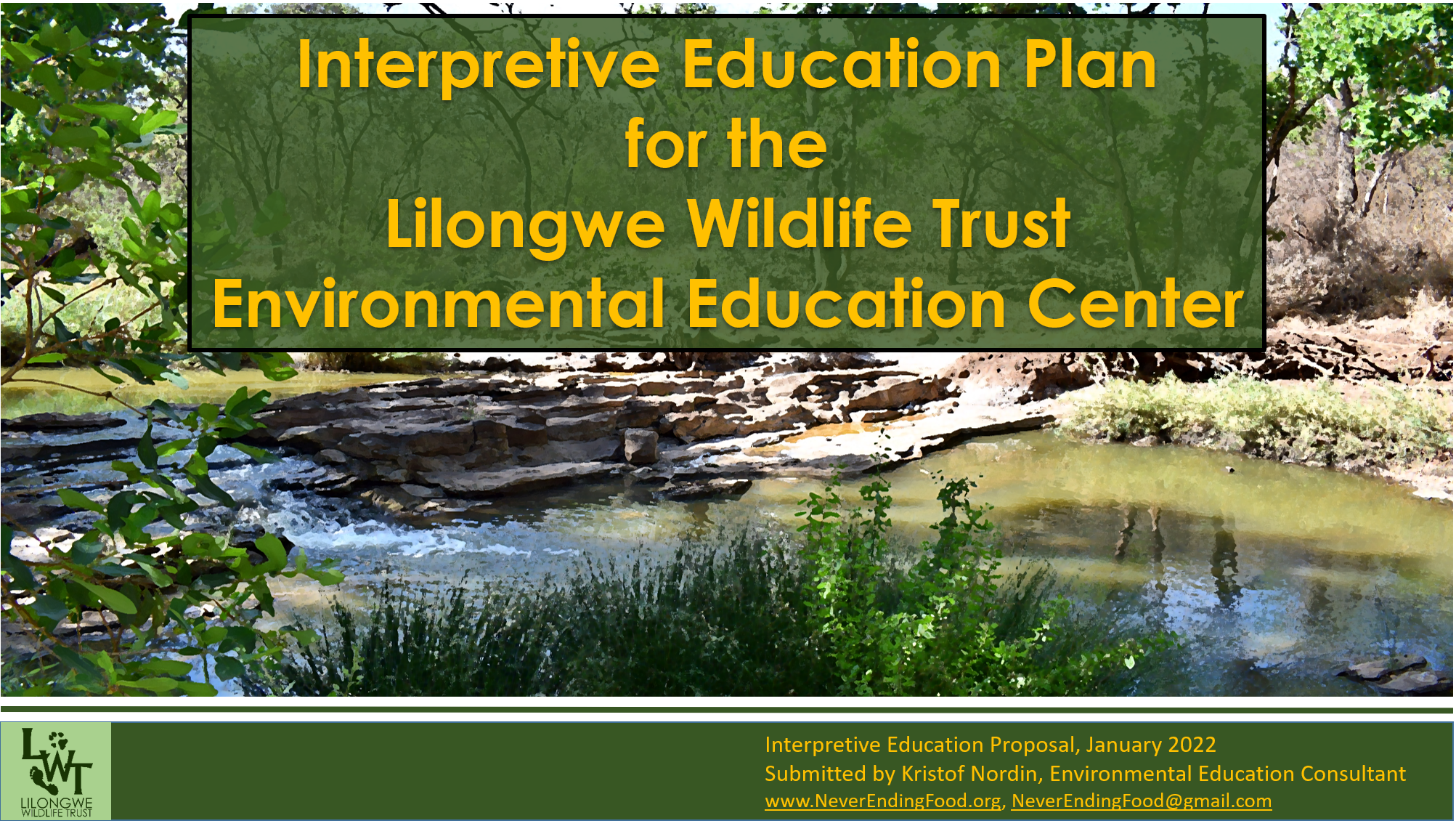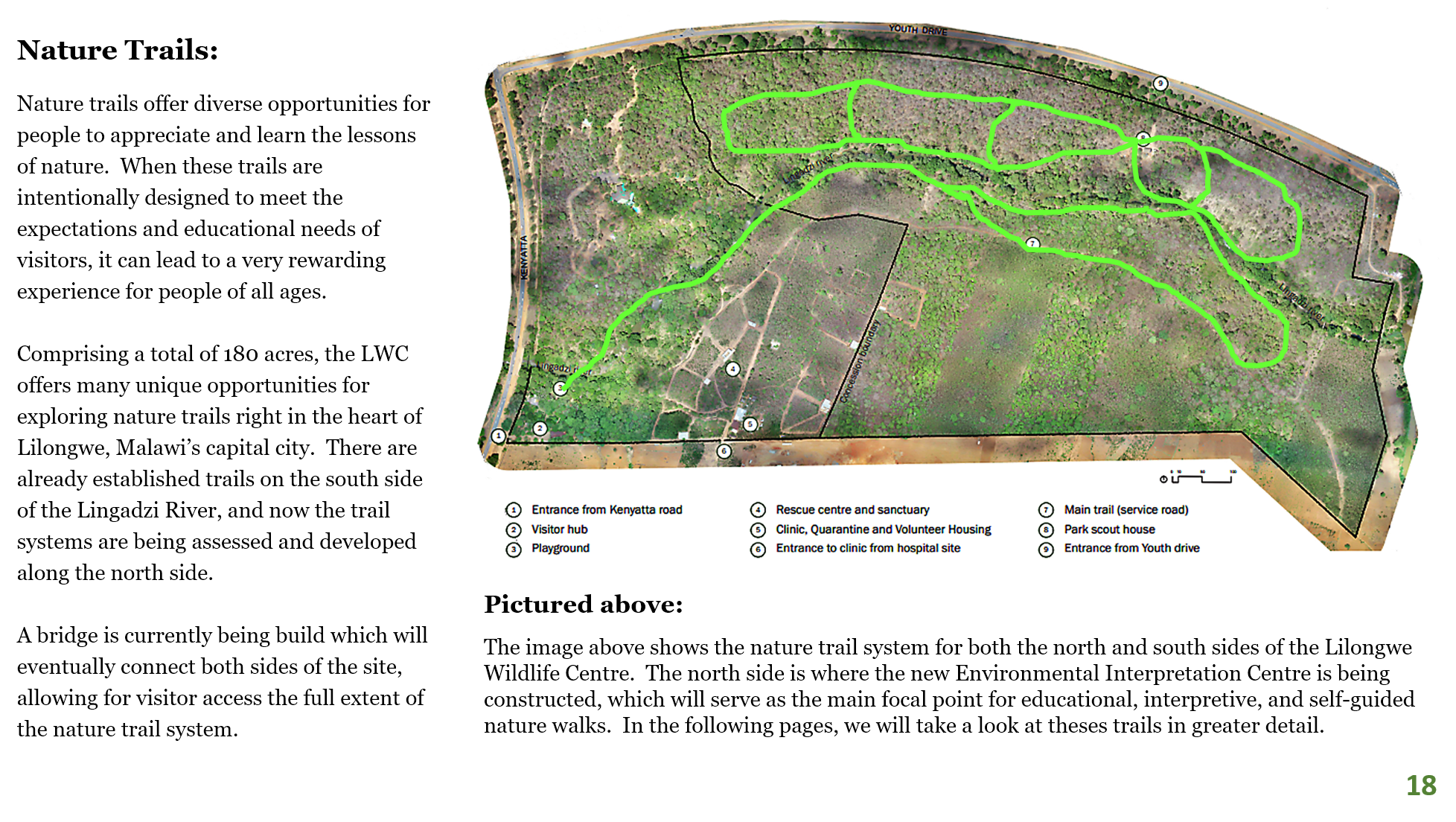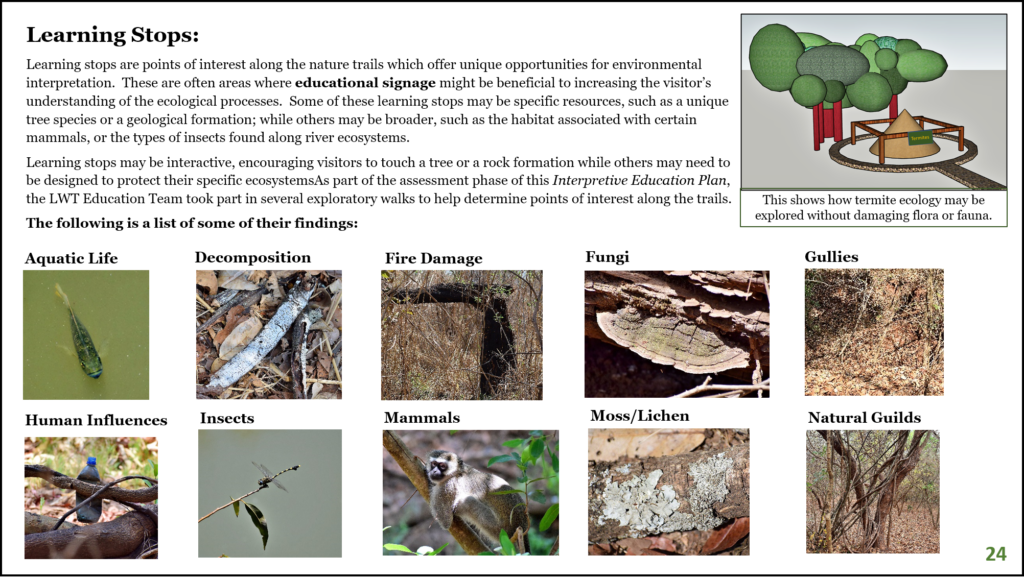
Kristof recently completed an Environmental Education consultancy with the Lilongwe Wildlife Centre (under the Lilongwe Wildlife Trust (LWT)) to assist with the development of a new Environmental Interpretation programme. In 2020, the Lilongwe Wildlife Trust (LWT) began work on Project GreenHeart, an initiative designed to upgrade the Centre’s wildlife rehabilitation facilities, develop brand new visitor experiences, expand the capacity for environmental education, develop new training opportunities for students and professionals in conservation-related fields, create nature-based jobs for local communities and promote a ‘green recovery’ from the COVID-19 pandemic. As part of this project, efforts are currently being undertaken to develop a new Environmental Interpretation Centre on the north side of the Lingadzi River. This area will contain roadside access, parking facilities, a reception area, a classroom, playground, amphitheater, a riverside boardwalk, a bird hide, educational nature trails, and a bridge which connects the north side to the existing facilities on the south side.

Kristof was asked to design an Interpretive Plan which focused on the following areas:
- Develop a creative new programme of learning experiences at LWC, ensuring that the goals of the programme are aligned with LWT’s overarching mission to save wildlife, campaign for conservation justice and inspire people to value and protect nature.
- Include a diverse range of content including activities as well as other fun and practical ways of engaging children with the site’s natural assets e.g. materials, experiences, exhibits, games, competitions, scavenger hunts etc.
- Prioritise learning experiences that are based on exploration, discovery and sensory engagement.
- Liaise closely with other LWT teams that are designing new interpretive signage across the whole LWC site, to ensure that messages and themes in the new educational programme are consistent.
- Ensure that the programme includes new and innovative ways of reaching and inspiring audiences alongside ‘tried and tested’ methods; and ensure that, where possible, these methods are informed by audience insights and needs assessments.
- Review content from other similar settings and programmes to assess replicability for LWT.
- Explore partnerships with other organisations and individuals to leverage additional expertise and opportunities (e.g. partnering with local cultural and arts organisations to showcase some of their nature-based work, bringing in other local partners to run complimentary activities and events etc).
- Work with LWT staff to develop M&E methods to measure the impact of the new programme.

As part of his work, Kristof worked closely with the Lilongwe Wildlife Centre’s Education Team to map out trails and identify unique ecological aspects for each area. These were identified as ‘learning stops,’ which may then be used to create signage, interactive activities, educational opportunities, or scenic rest areas. Comprehensive lists were also created for the majority of plants, trees, birds, mammals, and reptiles found within the site.

A large part of the Interpretive Plan was to help outline collaborative educational opportunities and activities that may be conducted in unison with other organizations, or used to help bring more visitors to the Centre. One major collaboration is the LWT’s role in assisting with the Lilongwe/Lingadzi Ecological Corridor System. This is a detailed plan developed for the city of Lilongwe to help protect, rehabilitate, and conserve the natural ecological systems along the Lilongwe and Lingadzi River systems which run through the heart of the capital. According to this initiative: “The Lilongwe and Lingadzi river system continues to be the most important source of water for Lilongwe City communities. The rivers and their surrounding areas also offer significant potential benefits for the City of Lilongwe: ecological, recreational, cultural and economic. However, the river system currently faces significant threats such as sand mining, pollution, urban developments, urban agriculture and climate change, which hinder the city from reaping these potential benefits. Another concern is the fragmentation of urban natural assets and green areas in the city; reducing this fragmentation is critical for improved resilience of Lilongwe City. River corridors are ideal for connecting various parts of a city, as well as provide the opportunity to unlock the benefits mentioned above. As such, the establishment of an ecological corridor system in Lilongwe City has been proposed. The future of this ecological corridor as the “heart and soul” of Lilongwe City depends on the large-scale and collective effort of all key role players. This work will help conserve the great value of the city’s natural assets, and allow the people of Lilongwe to benefit from the array of ecosystem services this ecological corridor may provide.”
While the entire Environmental Interpretation Plan will be a work in progress for several years (in terms of resource development), many of the learning opportunities are already up and running. School groups, churches, bird watchers, families and individuals are already welcomed to walk around this amazing area and explore some of nature’s wonders to be found in the heart of Malawi’s capital city! For more information on tours, educational opportunities, directions, and more, please visit the Lilongwe Wildlife Centre website by clicking here.
